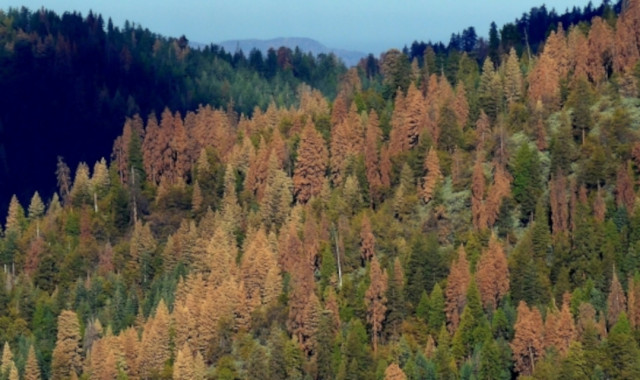The Sum of Its Plants

Nature tends to organize itself in a hierarchy of different scales, and scientists often find success focusing on just one level. Studying the behavior of a galaxy, for example, doesn’t necessarily require understanding its constituent stars, let alone the atoms and molecules that comprise them.
But someone has to connect these scales, which is precisely the aim of Leander Anderegg(link is external), an assistant professor in UC Santa Barbara’s Department of Ecology, Evolution, and Marine Biology. Anderegg studies how the traits and ecology within a single species of plant can influence the greater landscape — sometimes even beyond where that species is found. He’s particularly interested in how plants respond to climate change, and how those responses in turn influence ecosystem functions.
Fostering his continued research, the New Phytologist Foundation has awarded Anderegg its Tansley Medal, which is given annually “in recognition of an outstanding contribution to research in plant science by an individual in the early stages of their career.”
Receiving the Tansley Medal, Anderegg said, gives him added confidence in his research objectives. “The potential applicant pool is really large, which is pretty humbling,” he said. “It also feels like a validation that the questions I've been chasing are interesting and important, and I'm not just off in a corner studying something that no one else cares about.”
Anderegg takes a bottom-up approach to ecology. He studies how characteristics and adaptations vary within a single species across its range. With this basic information, he builds up an understanding of the stress that this species faces from climate change. He repeats this process for more species, gradually sussing out the general patterns across many species. “My goal is to derive an understanding about where and why certain species will be vulnerable or resilient to climate change so that we can tailor proactive management strategies for them,” he said.
His method of examining a single species growing in many places requires much more data than the traditional approach of comparing many species that grow in a single place. The work sees Anderegg driving long distances to take measurements across a species’ entire range. “And there’s a lot of hiking up mountains to study a species at multiple elevations,” he added. A lot of our understanding of plant physiology comes from comparing different species, but that doesn't translate to variation within a single species, he noted.
Researchers apply for the Tansley Medal competition, and finalists are asked to write a review article(link is external) in their area of expertise, which is featured in the foundation’s namesake journal. For his review, Anderegg investigated how scientists use plant traits to understand ecology, and why this approach occasionally shoots wide.
The paper considers plant “function traits,” which include attributes like how much photosynthesis a plant can carry out, how long its leaves live or how efficiently it moves water. These traits determine how a plant interacts with its environment, making them powerful tools to predict how plants will respond to climate change and other stressors.

However, when scientists look for general patterns about how these traits change across different conditions — for instance, from the tropics to the poles — they find that traits don’t generally show strong relationships with the environment. Noting the paradox as a major problem, Anderegg decided to break the issue down into a number of potential explanations.
He came up with a few insights, and the first is an issue of scale. “The processes driving trait changes can vary enormously whether you’re talking about variation within a species, among closely related species, among distantly related species, or among whole communities of plants,” Anderegg said. And the magnitude of the change varies as well. Within a single species, these changes are limited to small genetic differences between populations or non-genetic changes, such as acclimation to heat. This means that individual species are pretty constrained.
There’s also the challenge of knowing which traits to focus on. Scientists don’t always measure the right traits or understand how different traits impact a plant’s fitness in a given environment. What’s more, there’s often a connection between several traits, making it difficult to suss out the contribution of any specific trait in the group. For instance, longevity, morphology and physiological rates often covary in leaves.
“Long-lived, ‘401k’ leaves tend to be really thick and dense, have low nutrient concentrations and have slow metabolic rates,” Anderegg said. “While ‘live fast-die young’ leaves have short lifespans, are relatively flimsy, are chocked full of nutrients and have high rates of photosynthesis (and respiration).”
Anderegg’s observations highlighted how studying trait change at many ecological scales within individual species and across whole communities can lead to a better understanding of how traits fit together to make a whole, coordinated plant. “Hopefully then we can better predict how plants will respond to climate change,” he added.
Anderegg’s goals go beyond academic insight, though. He also aims for his research to help guide land management practices. Some of his research involves identifying where in the landscape plants are most vulnerable to drought so that these places can be targeted for management or restoration. He’s also exploring how fire influences tree health and water stress to help design prescribed burn treatments that can reduce fire risk while also making ecosystems more resilient to drought.
Debora Iglesias-Rodriguez, chair of the Department of Ecology, Evolution, and Marine Biology, offered her congratulations: “I am thrilled about Professor Anderegg’s well-deserved award. I am impressed by the breadth and depth of his work, and the Tansley Medal is an appropriate recognition for his outstanding contributions to physiological research.”
Anderegg joins a distinguished cohort of previous winners, including UCSB Assistant Professor Anna Trugman as well as his older brother, Bill Anderegg, at the University of Utah.
New Phytologist is a leading journal focusing on high quality, original research across the broad spectrum of plant sciences, from intracellular processes through to global environmental change. The journal is owned by the New Phytologist Foundation, an independent, not-for-profit organization dedicated to the promotion of plant science.